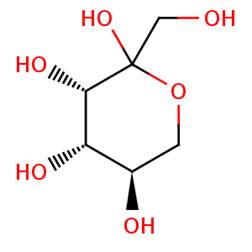Posted June 20, 2013: by Bill Sardi
In 2008 tagatose was declared a “new anti-diabetic and obesity control drug.” It was said to be in Phase 3 of a human clinical trial to address “the rapidly growing epidemic of type 2 (adult onset) diabetes.
The report said tagatose was initially developed by a company as a low calorie sugar substitute. It is sweet, but only 20% of orally ingested tagatose is fully metabolized, following a metabolic pathway similar to fructose.
Tagatose has gained FDA status as “generally regarded as safe (GRAS) which permits it to be used in foods and beverages. The report says “a 14-month trial confirms its potential for treating type 2 diabetes, and tagatose showed promise for inducing weight loss” as well. Tagatose was also identified as an antioxidant and prebiotic (favors good bacteria in the digestive tract).
Tagatose elicits a sweet taste, about the same sweetness as sucrose (table sugar).
A 5-gram (5000 milligram) dose of tagatose included a beverage in a group of adults with high blood sugar reduced their blood serum glucose level significantly. Tagatose had no blood sugar-lowering effect on healthy individuals.
It is also said that tagatose reduces food intake in healthy adults and diminishes a rise in blood plasma glucose when consumed with meals. A 15-gram (15,000 milligram) dose of tagatose taken 3 times a day with meals was employed. Hemoglobin A1c, a measure of long-term sugar control, declined modestly. Some gastric upset was reported at this high dose. There were reported improvements in body weight.
Tagatose is described as a “naturally occurring simple sugar that is a palatable low-calorie sweetener.” It was approved by the FDA as a food additive in 2003. It interferes with the absorption of carbohydrates (pasta, bread, rice). It provides only 1.5 calories per gram (1000 mg) versus 4 calories from sucrose or fructose since less than 20% is absorbed in the small intestine.
In laboratory animals, tagatose “does not result in the same extent of obesity, high blood sugar, elevated cholesterol and atherosclerosis” as sucrose-fed animals.
Tagatose is also reported to inhibit for formation of dental plaque.
While tagatose is now synthetically produced, its origin is found in nature. In fact, many drugs are derivatives of natural molecules. Tagatose, posed as an anti-diabetic drug, reveals yet another charade by drug companies. When examining tagatose it is molecularly similar to inositol, a non-patentable vitamin-like substance that is about 50% as sweet as sucrose and low in calories. Inositol powder is widely available. See the similarity of these molecules below. By molecularly altering inositol to become tagatose, a new drug was invented.
 |
 |
| Tagatose | Inositol |
Inositol is a simple sugar (carbohydrate), molecularly resembles glucose, and is about 50% the sweetness of table sugar. It is considered essential for human health and is added to baby formulas to mimic the composition of mother’s milk. Inositol helps to stimulate the release of calcium from its storage site inside living cells. Inositol is found in beans, nuts, rice, wheat germ and some meat. The most concentrated sources are beans, peas, whole grains, nuts, seeds (flax), bran. Inositol resembles glucose in its molecular structure. Like tagatose, it can be used as a non-caloric sugar substitute.
Inositol is a component of lecithin and is known as a lipotropic agent, that is, it inhibits the buildup of fats in the liver.
The diet provides on average around 1000 milligrams of inositol daily, but coffee depletes inositol.
Many women who are overweight struggle with irregularity of their menstrual cycle and have polycystic ovary, a condition associated with obesity and insulin resistance that results in infertility, excessive hair growth and acne. An overlooked study may provide hope to many women with this condition. Researchers in Italy conducted a study of 283 patients with polycystic ovary, with 136 of these women receiving 100 milligrams of inositol twice a day. Ovulation frequency was 23% in the inositol group and 13% in the placebo group. Significant weight loss (and leptin reduction) was reported in the inositol group. An increase in HDL cholesterol was also reported in the inositol group.
Another application for inositol supplements is its combined use with folic acid (vitamin B9) for treatment of erectile dysfunction among adult-onset male diabetics.
Researchers at the First Institute of Obstetrics and Gynecology, University La Sapienza, in Rome, Italy, report that poor blood sugar control can result in loss of nitric oxide production, a transient gas that dilates (widens) blood vessels. Lack of nitric oxide production can prevent the pressure of blood in the male penis from rising sufficiently to close off the penile veins, allowing blood to flow out of the penis instead of remaining trapped for an erection. The provision of 4 grams (4000 milligrams) of inositol, divided into three doses during the day, plus 400 micrograms of folic acid, has been shown to improve erectile dysfunction among diabetics.
Tagatose can be purchased online by the pound. One brand sells for less than $9.00/pound. It is also available in a combination with stevia.
Inositol powder derived naturally from rice bran is available in 8-ounce canisters, but is a bit pricier. (This author uses it to sweeten coffee or tea in the morning.) ©2013 Bill Sardi, Knowledge of Health, Inc.
Posted in Diabetes, Dietary Supplements ; No Comments »
You must be logged in to post a comment.
11
17
52
95
14
24
237
6
56
43
10
116
15
66
105